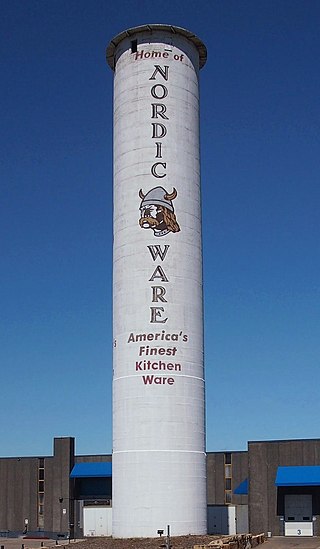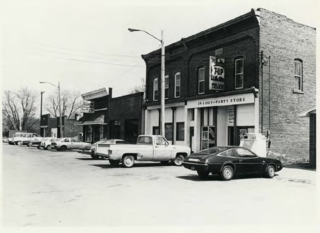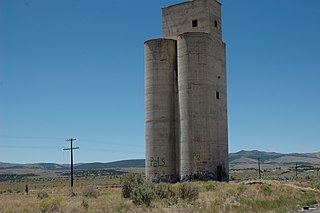
The Peavey–Haglin Experimental Concrete Grain Elevator is the world's first known cylindrical concrete grain elevator. It was built from 1899 to 1900 in St. Louis Park, Minnesota, United States, as an experiment to prove the design was viable. It was an improvement on wooden elevators that were continually at risk of catching fire or even exploding. Its cylindrical concrete design became the industry standard in the United States, revolutionizing grain storage practices. After its initial experiments, the Peavey–Haglin Elevator was never again used to store grain. Since the late 1960s it has been maintained on the grounds of the Nordic Ware company and is painted with their name and logo.

Armour's Warehouse, also known as the Seneca Grain Elevator or the Hogan's North Elevator, is a historic grain elevator located in the village of Seneca, Illinois, United States. The elevator and two surrounding outbuildings were listed on the U.S. National Register of Historic Places in 1997.

Silo Point, formerly known as the Baltimore and Ohio Locust Point Grain Terminal Elevator, is a residential complex converted from a high-rise grain elevator on the edge of the Locust Point neighborhood in Baltimore, Maryland. When the original grain elevator was opened in September 1924, it was the largest and fastest in the world. The first shipment of grain was processed on September 18, 1924. The condominium rises to 300 feet. The grain elevator was built by the Baltimore and Ohio Railroad in 1923–1924, with a capacity of 3.8 million bushels. In 2009 it had been converted from a grain elevator to a condominium tower containing 24 floors and 228 condominiums by Turner Development Group and architect Parameter, Inc.

Concrete-Central Elevator is a historic grain elevator located on the Buffalo River at 175 Buffalo River Buffalo in Erie County, New York.
The Adams Woodframe Grain Elevator is a grain elevator in Adams, Oklahoma. The elevator was built in 1926, the same year the community of Adams was established by the Tex-Co Grain Company. The Chicago, Rock Island and Pacific Railroad opened a line past the grain elevator in 1929, which linked Amarillo, Texas to Liberal, Kansas. The elevator has mainly held wheat, the primary crop in the area, and operated continuously from its opening to at least 1983. The grain was shipped by railroad from Adams to markets in either Fort Worth, Texas or Galveston, Texas On May 13, 1983, the elevator was added to the National Register of Historic Places. It was burned down around August 22, 2018 because of safety issues.

The Hooker Woodframe Grain Elevator is a grain elevator in Hooker, Oklahoma. The elevator was built in 1926 by the Riffe & Gilmore Co. and operated by the Wheat Pool Elevator Company. Located along the Beaver, Meade and Englewood Railroad, which ran from the east at Beaver, Oklahoma to the west at Keyes, Oklahoma, the elevator served the local wheat industry. It was one of several built to compete with the Chicago, Rock Island and Pacific Railroad elevators in the region. The elevator was added to the National Register of Historic Places on May 13, 1983 and is one of two National Register of Historic Places listings in Texas County, Oklahoma located around Hooker.

American Grain Complex, also known as "The American", Russell-Miller Milling Co. Elevator, and Peavey Co. Elevator, is a historic grain elevator and flour milling complex located in South Buffalo, Buffalo, Erie County, New York. The complex consists of three contributing buildings and two contributing structures. They are the Elevator Building, Flour Building (1906-1924), office building, Moveable Marine Tower, and railroad tracks. The Elevator Building consists of the mainhouse, workhouse, and fixed marine tower, all built in 1905–1906, and an annex constructed in 1931. The complex was last owned by ConAgra Foods, who closed the elevator and mill in June 2001.
The Baker Woodframe Elevator was a historic grain elevator in Baker, Oklahoma. The wood frame elevator was built for the Kimber Milling Company in 1926. The elevator was located at the intersection of the Chicago Rock Island and Pacific and the Beaver, Meade and Englewood. The railroad shipped wheat harvested in Baker to the Gulf Coast. The elevator operated until 1974, when the railroads ended their service to Baker. No remains of this elevator are evident. It existed just north of another elevator built in the 1970s that still remains.

The West Liberty Commercial Historic District in West Liberty, Iowa, United States, is a historic district that was listed on the National Register of Historic Places in 2002. At that time, it included 41 contributing buildings, six other contributing structures, and eight non-contributing buildings.

The Herschel-Spillman Two-Row Portable Menagerie Carousel, also known as the Story City Carousel, is a historic structure located in Story City, Iowa, United States. It was created by the Herschell Spillman Company of North Tonawanda, New York in 1913, and it has been owned and maintained by the Greater Community Congress of the City of Story City since 1938. Its "menagerie" of carved figures included horses, pigs, chickens and chariots. The Uncle Sam chariot, the pig and chicken pairs, and the lovers tub are all considered rare. The carousel utilizes an under-animal scissor support system, which is an example of an earlier and simpler technology in the development of the merry-go-round. Its early history is unknown, but it was designed for temporary set-up and use.
The Raymond Grain Elevators Historic District is a 6 acres (2.4 ha) historic district near Raymond, Montana with six contributing buildings which was listed on the National Register of Historic Places in 1993.

The Potter and Barker Grain Elevator is a historic grain elevator located at 1N298 La Fox Road in La Fox, Illinois. It is situated next to the La Fox station. The elevator was built in 1868 by former whaling ship captain Lemuel Potter and his brother-in-law Henry Barker. Part of a wave of industrial development in the Fox Valley, it served as a transfer point for grain being shipped along the Galena and Chicago Union Railroad. The elevator represents an intermediate point in the transition from one-story rural elevators to taller, mechanized second stage elevators. Its small capacity is typical of the older one-story elevators, but it includes mechanized systems of unloading and raising grain common to later structures.

The Grenola Mill and Elevator is a grain elevator complex on Railroad Avenue in Grenola, Kansas. It was built in about 1909 and was listed on the National Register of Historic Places in 2002.
The Floris Grain Elevator, located off U.S. Route 64 in Floris, Oklahoma, was built in 1900 or 1926.

The Rochester Grain Elevator, formerly the Griggs Brothers Grain Elevator, is a grain elevator located at 303 East University Drive in Rochester, Michigan. It was listed on the National Register of Historic Places in 2010.
The Turpin Grain Elevator, located off U.S. Route 64 in Turpin, Oklahoma, was built in 1925. It was listed on the National Register of Historic Places in 1983.
The Ross Grain Elevator is a historic building located in Ross, Iowa, United States. It was built in 1881 by Charles Stuart, a Civil War veteran who was a forwarding agent for the Chicago and Northwestern Railroad. The wooden structure rests on a limestone foundation. By the early 20th century the elevator was sheathed in corrigated steel to guard against the sparks that came off of the locomotives at the nearby depot, no longer extant. The elevator is made up of three interconnected buildings that include the elevator itself, an annex, and the brick scale-engine house. At one time the property contained two grain elevators, a depot, stock yards, cob houses, town dump, coal shed and other related structures. The railroad discontinued operations here in the 1940s, and the other buildings were removed over the years. The elevator itself was used on a farm into the 1970s. It has not been used since then, but its internal mechanisms are still extant. The elevator was listed on the National Register of Historic Places in 2018.

The Genesee Avenue–Walker Street Historic District is a primarily commercial- and railroad-oriented historic district, located along three blocks of Walker Street and one intersecting block of Genesee Avenue in Gaines, Michigan. It was listed on the National Register of Historic Places in 1983.

The Knight Grain Elevator, near Eureka, Utah, was built in 1915. It was listed on the National Register of Historic Places in 1979.
The Beaver, Meade and Englewood Railroad (BM&E) extended from Beaver, Oklahoma to Keyes, Oklahoma in the Oklahoma Panhandle, about 105 miles. It was chartered in 1912, and abandoned in 1972.














